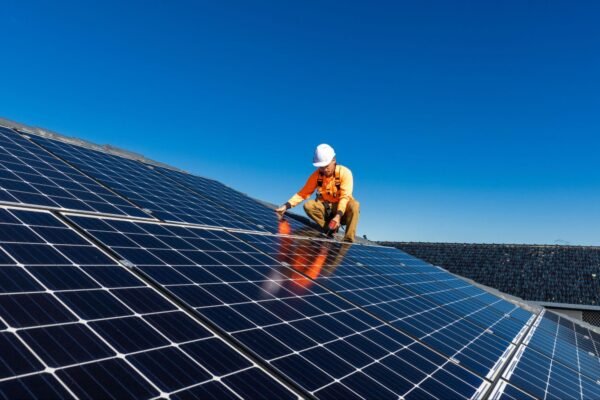Key Takeaways:
-
Heating and transportation are leading the charge in harmful emissions across the nation, so it’s important to focus on reducing this through electrification.
-
From electric vehicles to heat pumps, switching from fossil-fuel-reliant heating and transportation can have compounding impacts on climate change as time passes.
-
These changes are not without their flaws, as electric vehicles often still rely on fossil-fuel-based electricity, but they still emit fewer net emissions than gasoline vehicles.
-
Rebates, tax credits, and grants are helping make this technology more affordable for the masses, helping increase their adoption.
Across the U.S., there’s a growing shift toward electrifying how we move and stay warm during the cooler months. This shift, called the electrification of transportation and heating, means replacing gas-powered vehicles and fossil-fuel-based heating systems with electric alternatives, such as electric vehicles (EVs), hydrogen fuel cell vehicles, heat pumps, and more.
These changes are essential for reducing carbon emissions, improving air quality, and moving away from fossil fuel use. This transition also increases the pressure on our electric grid and requires innovative policies, planning, and infrastructure to avoid grid failure due to the extra electricity demand.
Below, we’ll explore the main benefits, challenges, and solutions behind this growing movement.

Plans With Perks
Enjoy free nights or weekends and earn bill credits, making your electricity plan work for you.
Benefits of Electrifying Transportation and Heating
The biggest reason to electrify transportation and heating is to lower greenhouse gas emissions. Gasoline vehicles and fossil-fuel-based heating systems are some of the top contributors to carbon emissions in the United States. In fact, the transportation sector is the single largest source of CO₂ emissions in the country.
Switching to electric vehicles eliminates tailpipe emissions. That means no more exhaust gases like carbon monoxide or nitrogen oxides, which harm the climate and public health. Even when you charge an EV using electricity from natural gas or coal, it still produces fewer net emissions than traditional gas-powered vehicles. Plus, as the power sector adds more renewable energy, the emissions from EVs drop even further.
Switching from oil or natural gas boilers to heat pumps significantly reduces emissions from heating homes and businesses. Unlike furnaces that burn fuel, heat pumps use electricity to move heat, which is more efficient. This leads to cleaner space heating and hot water production, especially when powered by clean electricity.
These electrified systems reduce energy consumption and help slow climate change.
How Does the Efficiency of Electric Heating Compare to Traditional Heating Systems?

Electric heating systems, especially heat pumps, are much more efficient than traditional systems that burn fuel. A gas furnace might be 90% efficient, meaning 10% of the fuel energy is lost during the heating process. In contrast, heat pumps can be up to 400% efficient. That means for every unit of electricity used, they produce four units of heat.
Heat pumps use less energy because most of the heat from them is transferred from one place to another rather than created. This improved energy efficiency results in lower operating costs and a reduced environmental impact.
Electric water heaters have also become more efficient. Heat pump water heaters, for example, use a fraction of the electricity compared to older models.
So not only are electric heating systems better for the planet, they also make better use of your energy dollars.
What Are the Biggest Challenges in Scaling Up EV Adoption?
Although electric vehicles are growing in popularity, a few big challenges remain. Solving these problems requires coordinated efforts between automakers, policymakers, and the energy sector.
Here are some key issues.
Upfront Cost
Even though EV prices are falling, most still cost more than traditional gas-powered light-duty vehicles. That price gap can deter buyers, even if the total cost of ownership is lower over time.
Charging Infrastructure
We need more charging stations nationwide, especially in areas where people can’t install home chargers. The lack of a broad charging network makes some drivers hesitate to switch to EVs.
Range Anxiety
Many electric cars now offer 200 to 300 miles of range or more. However, some drivers still worry about running out of battery, especially on longer trips.
Battery Supply
Producing more EVs means mining more lithium, nickel, and cobalt. These materials are critical for batteries but raise environmental and ethical concerns. Battery recycling is on the horizon, but the technology is still maturing.
Public Awareness
Many people are still unfamiliar with EVs or have outdated views about them. Education is key to accelerating adoption.
How Does the Cost of Ownership of EVs Compare to Gas Vehicles?
While many people focus on the sticker price, the total cost of ownership of electric vehicles is often lower than for cars with an internal combustion engine. Here’s why:
- Lower fuel costs: Charging an EV at home can be far cheaper than filling up a gas tank.
- Lower maintenance: EVs have fewer moving parts. They don’t need oil changes, and due to regenerative braking, their brakes last longer.
- Incentives: Federal and state tax credits, rebates, and other perks can cut costs by thousands.
- Longevity: Many EV batteries are now designed to last over 200,000 miles.
Studies show that most EVs in the U.S. become cheaper to own than similar gas vehicles after the five-year mark. This is especially true for people who drive more miles yearly or can charge at home during off-peak hours.

How Can Power Grids Handle the Electricity Demand from Widespread Electrification?
As more people electrify their transportation and homes, electricity demand will rise. This can put pressure on local power grids, especially during peak times.
However, utilities and electric grid managers are preparing in several ways:
- Smart chargers: These allow EVs to charge during off-peak hours, like overnight, reducing grid strain during high-use periods.
- Demand response programs: These shift power from low-demand to high-demand areas when the grid is stressed.
- Battery storage: Large-scale batteries can store excess power and release it when needed.
- Upgraded infrastructure: New transmission lines and local upgrades support growing demand.
Electric utilities are also exploring tools like vehicle-to-grid (V2G) systems, where EVs send power back to the grid during high demand. This creates a two-way relationship between vehicles and the power system.
With planning, technology, and time-of-use pricing, the grid can handle the growth from electrification and even become more stable.
Renewable Energy and the Electrification of Transportation and Heating
The environmental benefits shrink if EVs and heat pumps are powered by coal. So, we need to power these systems with renewable energy to maximize the benefits of transportation electrification and electric heating.
That’s why solar energy, wind, and other clean sources are vital. They replace fossil fuel-based electricity generation with clean energy, reducing the total greenhouse gas emissions from the supply and demand sides.
As we add more renewable energy sources, the grid becomes cleaner. That makes every electric mile driven and every kilowatt of electric heat more climate-friendly. Plus, renewables are often cheaper and more stable in price than fossil fuels.
This combination of electrification and renewable power is the backbone of the U.S. energy transition.
Is your energy provider letting you down? Explore electricity plans for Texas.
Which Incentives Have Been Most Effective in Accelerating Electrification?
Government incentives have played a big role in promoting the shift toward electric transportation and heating. Some of the most effective tools include:
- EV tax credits: Up to $7,500 off the purchase price of qualifying electric cars.
- Heat pump rebates: Programs that reduce the cost of installing heat pumps and other efficient appliances.
- Infrastructure grants: Federal funds to expand charging infrastructure, especially along highways.
- Building codes: Requirements for new homes to be “electric-ready” or fossil fuel-free.
- State-level policies: States like California are leading with aggressive emission reduction targets and support for clean tech.
These policies help lower the cost barrier and signal to businesses and homeowners that the transition to clean energy is a priority.
Same Day Spark
Sign up before 12:00 pm CT, and we’ll have your power up and running the same day.
What Are the Tech Advancements Needed to Improve Battery Life and Cut Costs?
Batteries are essential for electric vehicles, and improving them will speed up adoption. Key areas of innovation include:
- Higher energy density: Allowing cars to drive farther without increasing battery size.
- Faster charging: Reducing time at the charger with new chemistries and cooling systems.
- Lower cost materials: Using alternatives to cobalt or nickel to reduce costs and reliance on rare metals.
- Recycling: Recovering valuable materials from old batteries for reuse.
- Solid-state batteries: A promising next-gen technology that could increase safety and reduce weight.
These advances will help make EVs more affordable, more convenient, and longer-lasting.
How Does Building Electrification Impact Energy Efficiency and Grid Resilience?
Switching to electric appliances improves energy efficiency in buildings. Heat pumps, for example, use much less power than traditional heaters and can cool and heat with one device.
Beyond efficiency, building electrification can improve grid resilience by using smart electric systems, which can:
- Shift energy use to off-peak hours
- Store thermal energy during the day and use it at night
- Respond to grid signals to reduce load during emergencies
This makes electrified buildings more than just efficient. They can also be active players in helping the grid stay balanced, especially during extreme weather or high demand.
What Are the Economic Implications of Transitioning to Electrified Alternatives?
The move to electrify our homes and vehicles will have major effects on the economy and job market as we transition away from fossil-fuel based systems.
Positive Impacts
- Job creation: Growth in clean energy, EV manufacturing, and building upgrades.
- Local work: Installing charging stations, heat pumps, and solar panels supports skilled trades.
- Lower bills: Over time, people spend less on fuel and maintenance, freeing up money for other needs.
Transition Challenges
- Some jobs in oil and gas may be lost or need to shift to new industries.
- Training will be needed for workers to move into clean energy fields.
With the right planning and policies, the energy transition can boost the economy and create millions of new jobs.

Electrification Can Play a Big Role in Reversing Climate Change
The electrification of transportation and heating is a powerful tool in the fight against climate change and pollution as we build a more affordable energy future.
By switching to electric vehicles, upgrading homes with heat pumps, and supporting renewable energy, we can reduce our reliance on fossil fuels and improve our lives.
The road ahead involves smart policy, better infrastructure, and continued innovation. But the benefits, such as cleaner air, lower energy costs, and a more resilient electric grid, are well worth the effort.
As we progress toward these changes, you can make your own changes at home by choosing a green energy plan. Explore Just Energy’s residential electricity plans and our JustGreen add-ons.
Brought to you by justenergy.com
All images licensed from Adobe Stock.
The post Electrification of Transportation and Heating: A Clear Path Forward appeared first on Just Energy.














